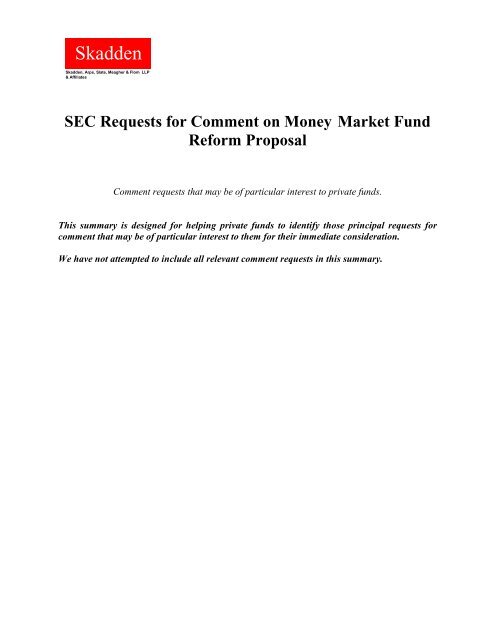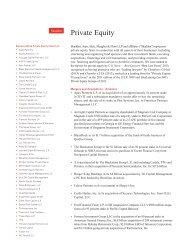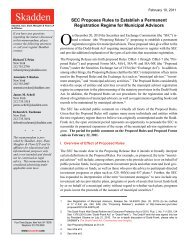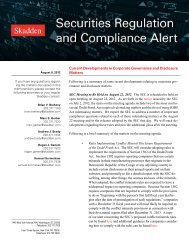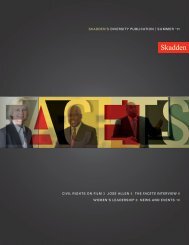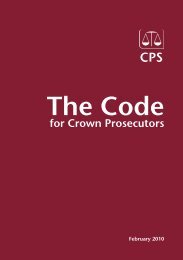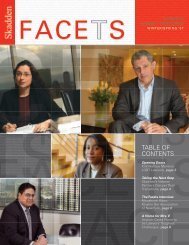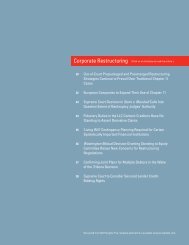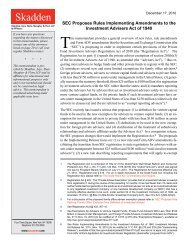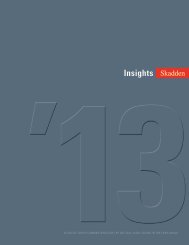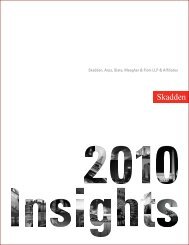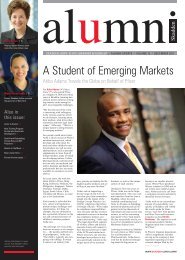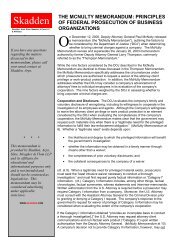Private Funds - Skadden
Private Funds - Skadden
Private Funds - Skadden
Create successful ePaper yourself
Turn your PDF publications into a flip-book with our unique Google optimized e-Paper software.
<strong>Skadden</strong><strong>Skadden</strong>, Arps, Slate, Meagher & Flom LLP& AffiliatesSEC Requests for Comment on Money Market FundReform ProposalComment requests that may be of particular interest to private funds.This summary is designed for helping private funds to identify those principal requests forcomment that may be of particular interest to them for their immediate consideration.We have not attempted to include all relevant comment requests in this summary.
The SEC is requesting comment with respect to:A. Floating Net Asset Value1. Certain Considerations Relating to the Floating NAV Proposalc. The performance of other floating NAV investment products during the 2007-2008 financial crisis.• Do commenters agree with the distinctions the SEC identified between money market funds under theSEC's proposed floating NAV and money market funds in other jurisdictions and U.S. ultra-short bondfunds? Are there similarities or differences the SEC has not identified?E. Macroeconomic Effects of the Proposals1. The effects the floating NAV or liquidity fees and gates proposals would have on current money market fundinvestments.• Do commenters believe that the likely effect of either the SEC's floating NAV proposal or the SEC'sliquidity fees and gates proposal would be to cause some investors to shift their money market fundinvestments to alternative products and thus reduce the amount of money market fund assets undermanagement? If so, to what extent and why? To what extent would these shifts vary depending onwhether the investor was retail or institutional and why?• Would either of the SEC's proposals result in any reduction in the number of money market fundsand/or consolidation of the money market industry? How many funds and what types of money marketfunds would leave the industry? What would be the effect on assets under management of differenttypes of money market funds if the SEC adopts either the floating NAV or liquidity fees and gatesproposal?• To what extent under each alternative would retail and institutional money market fund investors shiftto investment alternatives, including managing their cash themselves?• Would certain investment alternatives that have significant restrictions on their investor base beunavailable for current money market fund investors? If so, which alternatives and to what extent?• Do commenters agree with the SEC's analysis of the likelihood that certain shareholders would seekout particular investment alternatives in the event the SEC adopted either of the SEC's floating NAV orliquidity fees and gates proposals? For example, would institutional investors be unlikely to shift assetsto bank deposits (because of depository insurance limits) or local government investment pools, shortterminvestment funds, or offshore money market funds (because of the significant investmentrestrictions)? Do commenters agree with the SEC's analysis with respect to some or all of thesealternatives? Why or why not?• Are there aspects of any investment alternatives other than operational costs discussed in the proposalor other factors the SEC has identified that would affect whether money market fund investors wouldbe likely to use other investment alternatives in lieu of money market funds under either of the SEC'sproposals? The SEC requests that commenters differentiate between short-term effects that wouldoccur as the industry transitions to one in which money market funds use floating NAVs or liquidityfees and gates and the long-term effects that would persist thereafter.• Under each of the two proposals, what fraction of prime money market fund assets might be moved togovernment money market funds, retail funds, or to other alternatives (and to which alternatives)? Howwould these answers differ for retail investors and institutional investors?2
F. Amendments to Disclosure Requirements2. Daily Disclosure of Daily Liquid Assets and Weekly Liquid Assetsa. Proposed amendments to rule 2a-7 that would require money market funds to disclose daily thepercentages of fund assets invested in daily and weekly liquid assets, as well as the fund’s net inflowsor outflows.• Would disclosure of money market funds’ liquidity levels, coupled with portfolio holdings reported onForm N-MFP (and more frequent portfolio holdings disclosure on funds’ websites, to the extent theSEC determines to require this), enable other market participants to infer a fund’s potential liquiditydemand and likely trading needs by the fund? Would this disadvantage a money market fund in anyway?H. Amendments to Form N-MFP Reporting Requirements4. The new proposal to make Form N-MFP publicly available immediately upon filing.• Is a 60-day delay in making the information public still necessary to protect against possible “frontrunning” or “free riding?” Have any developments occurred that should cause the SEC to reconsider its2010 decision that the information required to be disclosed would not be competitively sensitive?• Would a shorter delay (45, 30, or 15 days) be more appropriate? If so, why?I. Amendments to Form PF Reporting Requirements1. Proposed amendments to Form PF.• Would the portfolio holdings information the SEC proposes to require large liquidity fund advisers tofile on Form PF, together with the other information that advisers already must file on the form,appropriately identify the ways in which their liquidity funds might generate systemic risk? Are thereways these liquidity funds could create systemic risk, particularly if the SEC was to adopt any of themoney market fund reforms the SEC is proposing, that would not be reflected in the additionalinformation?• Should the SEC require large liquidity fund advisers to file additional or different information abouttheir liquidity funds? If so, which information and how would that information be useful to FSOC andthe SEC? Do commenters expect they would derive efficiencies from the SEC requiring large liquidityfund advisers to file the same types of information that must be reported on Form N-MFP?• Is the SEC's proposal to require more comprehensive liquidity fund reporting by large liquidity fundadvisers appropriate? Should the SEC, instead, create a new subcategory of large liquidity fundadvisers who would be subject to these additional reporting requirements? If so, how should the SECdefine that subcategory? Would requiring only those large liquidity fund advisers with a moresubstantial amount of combined liquidity fund and money market fund assets under management—forexample, $10, $25 or $50 billion—allow the SEC to more effectively achieve its goals?• Rather than require all large liquidity fund advisers to file portfolio holdings information with respectto each of their liquidity funds, should the SEC define “qualifying” liquidity funds and require anyadviser to such a fund, potentially including advisers that are not large liquidity fund advisers, to filethis more comprehensive information? If so, why, and how should the SEC define such a qualifyingliquidity fund? Should the SEC define a “qualifying liquidity fund” as a liquidity fund that, togetherwith funds managed in parallel with the liquidity fund, is at least a certain size? What size would beappropriate (e.g., $100 million, $500 million, $1 billion)?• Should the SEC retain its proposed approach but provide an exemption for de minimis liquidity fundsfor which no additional reporting would be required? This would require a large liquidity fund adviserto provide portfolio holdings information about all of its liquidity funds except those that qualified forthe de minimis exemption. Such an approach would prevent an adviser that is a large liquidity fundadviser primarily because of its money market funds assets under management from having to fileportfolio holdings information for a relatively small liquidity fund (e.g., an adviser with $10 billion inmoney market fund assets under management and a single liquidity fund with only $10 million inassets under management). Would this minimize reporting burdens on advisers to smaller or start up3
liquidity funds that are less likely to have a systemic impact while still providing the SEC and FSOCinformation about the adviser’s short-term investing activities, which in the aggregate may be relevantto an assessment of systemic risks? How would the SEC structure such a de minimis exemption?Should it be based solely on the size of a liquidity fund and funds managed in parallel with theliquidity fund? Would a $1 billion threshold be appropriate because it would ensure that large liquidityfund advisers are only required to provide portfolio holdings information for relatively large liquidityfunds?• Do commenters agree that the new information the SEC proposes to require advisers to provide wouldbe useful to FSOC and the SEC for the reasons discussed by the SEC? Do commenters believe that theinformation would have the effects on capital formation, competition, and efficiency that the SECdiscussed? Why or why not? Would there be additional effects that the SEC has not discussed?• Do commenters agree with the SEC's assessment of the potential sensitivity of the information itproposes to require advisers to provide? Why or why not? To the extent advisers view the proposedinformation as sensitive and are concerned about the information’s inadvertent or inappropriatedisclosure, is there other information the advisers view as less sensitive that would achieve the SEC'sgoals?• The SEC proposes to require large liquidity fund advisers to provide this new information quarterlywith the information broken out monthly. Should the SEC instead require these advisers to file theinformation more or less frequently? Would a monthly reporting requirement, consistent with Form N-MFP, be more appropriate?• The SEC's proposed amendments to Form PF are designed to enhance FSOC’s ability to monitor andassess systemic risks in the short-term financing markets and to facilitate the SEC's oversight of thosemarkets and their participants, particularly in the event that further money market fund reforms causeinvestors to seek alternatives to money market funds, including private funds. Further money marketreforms also could incentivize investors to seek out money market fund alternatives that are registeredwith the SEC, such as ultra-short bond mutual funds. Information about these and similar funds’portfolio holdings also could be useful to the SEC and FSOC, particularly when combined with (orconsidered together with) information money market funds and advisers would file on amended FormsN-MFP and PF. Should the SEC therefore require registered investment companies that invest in theshort-term financing markets to file the same information money market funds must file on Form N-MFP and in the same format and with the same frequency to facilitate comparisons? If so, how shouldthe SEC designate which funds would be subject to this new requirement?N. Proposed Compliance DateThe proposed compliance period.• Should the SEC provide a longer or shorter compliance period with respect to any of the SEC'sproposed amendments? If so, why and of what length? How long would it take to implement eachprovision of the SEC's proposed amendments? Are there any provisions that should go into effectimmediately? Others that should be provided an even longer compliance period?• Would the SEC's proposed compliance periods and transition times provide sufficient time for fundgroups to determine their preferred approach to implementing any regulatory changes and conduct anynecessary operational changes?• Would the SEC's anticipated compliance dates and transition times allow investors sufficient time toevaluate the changes and determine their preferred course of action?• If any of the proposed amendments were to result in investors substantially reallocating capital, arethere other steps the SEC could take that it has not considered to mitigate any adverse effects on theshort-term financing markets and capital formation during the transition?4


